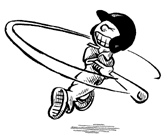
|
Physics and Acoustics of Baseball & Softball Bats
Daniel A. Russell, Ph.D. Graduate Program in Acoustics The Pennsylvania State University The contents of this page are ©2003-2011 Daniel A. Russell | 
|

|
Physics and Acoustics of Baseball & Softball Bats
Daniel A. Russell, Ph.D. Graduate Program in Acoustics The Pennsylvania State University The contents of this page are ©2003-2011 Daniel A. Russell | 
|
What and Where is the Center-of-Percussion?A solid object which oscillates about a fixed pivot point is called a physical pendulum. When displaced from its equilibrium position the force of gravity will attempt to return the object to its equilibrium position, while its inertia will cause it to overshoot. As a result of this interplay between restoring force and inertia the object will swing back and forth, repeating its cyclic motion in a constant amount of time. This time, called the period, depends on the mass of the object M, the location of the center-of-mass relative to the pivot point d, the rotational inertia of the object about its pivot point I, and the gravitational field strengh g according to Instead of being distributed throughout the entire object, let the mass of the physical pendulum M be concentrated at a single point located at a distance L from the pivot point. This point mass swinging from the end of a string is now a "simple" pendulum, and its period would be the same as that of the original physical pendulum if the distance L was  |
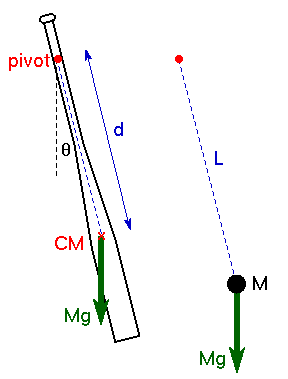
|
What is so special about the COP?Almost any physics textbook which mentions the center-of-percussion of a physical pendulum associates it with the "sweet spot" of a baseball bat[2-5] - that special place where an impact with the ball feels the best in your hands. It is relatively easy to show how this works, though I'll refrain from displaying the math equations here. Consider the figure at the right, which shows a bat suspended from a point P on the handle. If an impact force F were to strike the bat at the center-of-mass (CM) then point P would experience a translational acceleration - the entire bat would attempt to accelerate to the left in the same direction as the applied force, without rotating about the pivot point. If a player was holding the bat in his/her hands, this would result in an impulsive force felt in the hands. If the impact force F strikes the bat below the center-of-mass, but above the center-of-percussion, point P would experience both a translational acceleration in the direction of the force and a rotational acceleration in the opposite direction as the bat attempts to rotate about its center-of-mass. The translational acceleration to the left would be greater than the rotational acceleration to the right and a player would still feel an impulsive force in the hands. If the impact force strikes the bat below the center-of-percussion, then point P would still experience oppositely directed translational and rotational accelerations, but now the rotational acceleration would be greater. However, if the impact force strikes the bat precisely at the center-of-percussion, then the translational acceleration and the rotational acceleration in the opposite direction exactly cancel each other. The bat would rotate about the pivot point but there would be no net force felt by a player holding the bat in his/her hands.[6,7]Because impacts at the center-of-percussion result in zero net force at the pivot point, this location has long been identified with the sweet spot, associated with feel, of a baseball bat. However, there is a problem with this identification because the location of the COP is completely dependent on the location of the pivot point. For every location on the handle there is a corresponding location on the bat barrel which acts as a center-of-percussion for that specific handle location. The traditional assumption, supported by some early experimental studies,[8] is that when a player swings at a ball, the bat pivots about a point on the handle under the hands, roughly 6-inches from the knob. As we will see later in this article the most recent experimental evidence reveals that the pivot point is neither on the handle under the hands, nor at the wrist of the player swinging the bat. First, though, I want to take a look at how this special location on the bat has affected the manner in which bat performance is measured.
| 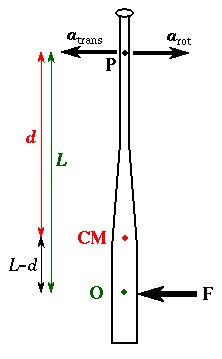 |
|
The problem with these standardized tests is they all require the impact between ball and bat to occur at the experimentally determined center-of-percussion of the bat relative to a pivot point on the handle 6-inches from the knob. As early as 1986, theoretical analyses showed that the COP was not the location on a wood bat where the resulting ball speed would be maximized,[6] but experimental evidence was not yet available to confirm this. Most researchers believed that because the COP location was widely held to be the location where impacts felt the best to the hitter, and thus the term "sweet spot," it was assumed that this location would provide the best assessment of performance for hollow bats as well. However, in the year 2000 important experimental results were published showing that, at least for hollow softball bats tested using the BPF test, the center-of-percussion was not the location where maximum ball speed occurs.[10]
The figure at right shows the locations of the center-of-percussion (small black dots) and the experimentally determined location producing the highest batted-ball speed (big white circles) for a variety of slow-pitch softball bats. The data in the figure includes two wood bats, and a variety of aluminum and composite hollow bats covering a range of performances. Notice that for only one of the bats is the location of maximum batted-ball speed within 0.25-inches of the center-of-percussion. Also notice that for the two wood bats the max-BBS location is further from the barrel end than the COP, while for almost all of the hollow bats the COP is closer to the barrel end (the one exception is the data point at the top of the figure which is for a very low performing 1970's vintage aluminum bat). |
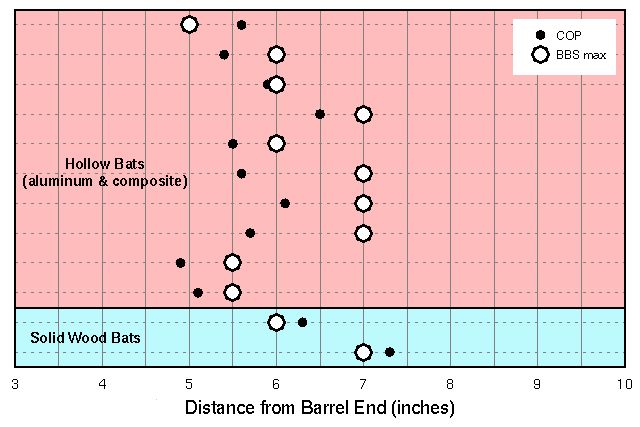
|
|
By late 1999 troubling evidence began surfacing which suggested that by altering the moment-of-inertia (ie, by adjusting the location of the center-of-mass) it was possible to design a baseball or softball bat that would pass the BESR test but would perform much higher in the field.[11] Essentially, manufacturers were able to cheat the test by manipulating the location of the COP. The figure at right shows experimentally determined bat performance as measured by the "bat-ball coefficient-of-restitution" (BBCOR) mentioned above in reference to the BPF test. The higher the BBCOR, the faster the ball comes off the bat. The blue data points are for an unmodified bat. Notice that the location of maximum performance is at 7-inches from the barrel end, while the location of the COP for this bat is only 5.75 inches from the barrel end. If the bat was tested at the COP the measured BBCOR would be 0.595 instead of the actual maximum value of 0.600. The red data points show the effect of adding 3-ounces of mass to the knob of the handle. Notice that the performance curve is essentially unaffected - that is, the maximum BBCOR is still 0.600 at a distance of 7-inches from the barrel end of the bat. But, the location of the COP has now shifted almost an inch closer to the barrel end. So, if the altered bat was tested at its COP the measured BBCOR would only be 0.575 instead of the actual maximum 0.600.
The reason for this shift in the location of the COP is the fact that the location of the COP depends on the total mass of the bat as well as the balance point and the moment-of-inertia (see the equation defining the distance L above). Adding 3 ounces to the knob of the bat increases the weight but also shifts the balance point towards the handle so that the moment-of-inertia does not change. As a result the performance of the bat, which depends on the inertial properties of the bat, is unaffected while the location of the COP is significantly changed. Similarly, by moving a small amount of mass from the barrel end of the bat to the handle end, the balance point and moment-of-inertia could be manipulated without altering the total weight of the bat. By changing the MOI and balance point, the location of the center-of-percussion also changes. Clever manufacturers began designing bats which would pass the BPF and BESR tests, which were conducted at the bat's COP, but which would perform significantly higher in the field. Fingers should not be pointed only at manufacturers, however. I have been informed by engineers from two different bat companies that they were told by an association that if they were to shift a fraction of an ounce of mass from the barrel end to the handle end, a specific bat model would end up passing the test and wouldn't end up being banned.
|
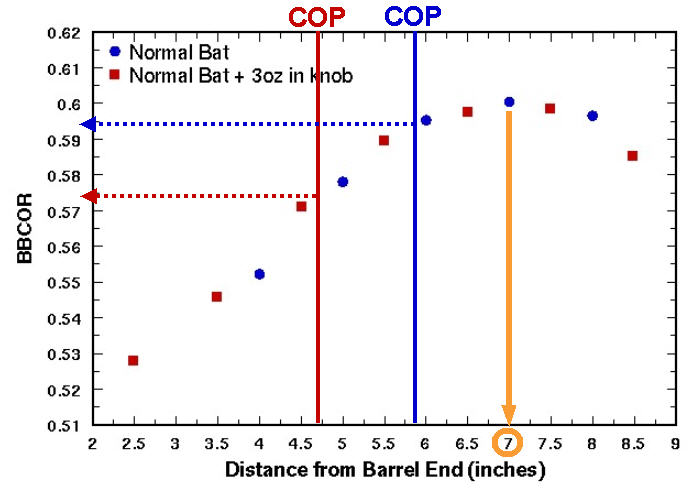
|
The discoveries that the COP relative fo the 6-inch point on the handle is (i) not the location where bat performance is measured to the greatest, and (ii) may be manipulated by moving mass to adjust the location of the center-of-mass, is one of the concerns that encouraged the development of a new test standard for measuring softballs. The other primary discovery was that the 60mph speed of the old standard was much lower than the relative speed between ball and bat of 110mph as measured in the field. The new softball standard, ASTM F2219 fires softballs at 110mph towards bats and scans the impact location along the barrel until the maximum performance location is found. Then testing is conducted at the experimentally detemined maximum location. However, the ASA is the only softball association to adopt this new test standard. The USSSA, ISF, NSF, and others still use BPF test according to ASTM F1890 which uses the slower speed and impacts bats at the COP. Likewise, Little League baseball still uses the BPF 1.15 rule according to ASTM F1881 which also still specifies impacts at the COP. The NCAA, however, has modified their bat certification process for baseball bats using the BESR test on the Baum Hitting MachingTM so that the impact location is scanned along the barrel until the maximum performance location is found.
| When I defined the center-of-percussion earlier, I stated that the location of the COP depends on the location of the pivot point. For the last twenty years researchers have followed the assumption that the pivot point is under the hands, or at least at the wrists, during the rotation and impact with the ball.[8] Recent experiments have conclusively shown this not to be the case. Two very thorough experimental field studies - one for softball bats[12] and the other for baseball bats[13] - with real players swing bats at pitched balls used 3-D video systems carefully tracked the motion of the bat during the entire swing. Both studies showed that during the impact with the ball the instantaneous center of rotation (ie, the pivot point) is not at the 6-inch point on the handle, nor is it at the wrists. Instead it is located about 2.5 inches beyond the knob end of the handle and about 2.5 inches off of the axes of the bat. The figure at right shows the raw data collected from a dozen Class-A slow-pitch softball players, each taking about two dozen good hits. The various colored data points represent individual players. The larger black dot in the middle of the data points is the average pivot location for all hits across all players. The scatter of the data indicates that the pivot point varies not only from player to player, but also from swing to swing for each player. Notice that none of the measured pivot points is within 2 inches of the black dot on the handle - which is at the 6-inch point used to measure the COP and which was formerly used to determine the point on the barrel where performance testing should occur. |
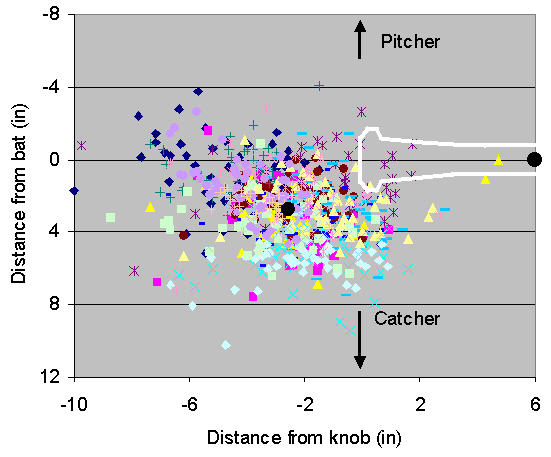
|
It is true that the COP is the location where no net force is exerted at the pivot point. However, the recently discovered fact that the actual pivot point at the instant of collision is not on the hands under the handle, but about 2.5 inches completely beyond the end of the handle, renders the COP relative to the 6-inch point on the handle irrelevant. If the defacto pivot point during the collision is not on the handle, then there is no point on the handle where the net force is exactly zero and the COP is meaningless as a definition of the sweet spot. Recent experimental evidence for hand-held tennis racquets[18-19] agrees with the results for baseball and softball bats. The location of the pivot point is not under the hands. Thus, the center-of-percussion relative to a pivot point on the handle is not representative of the actual playing conditions and cannot be the "sweet spot" location that feels best.
[1] ASTM F 1881-04: Standard Test Method for Measuring Baseball Bat Performance Factor, and ASTM F 1890-04: Standard Test Method for Measuring Softball Performance Factor, Annual Book of ASTM Standards, Vol. 15.07 (ASTM International, West Conshohocken, PA, 2004). The procedures for measuring moment-of-inertia and locating the center-of-percussion will soon be incorporated into a separate standard, ASTM F 2398: Test Method for Measuring Moment of Inertia and Center of Percussion of a Baseball or Softball Bat.
[2] R. Resnick, D. Halliday, and K.S. Krane, Physics 5th Ed., (John Wiley & Sons, 2002) p.382-383.
[3] L.A. Bloomfield, How Things Work, The Physics of Everyday Life, (John Wiley & Sons, 1997) p.100.
[4] K. R. Symon, Mechanics, 3rd Ed., (Addison-Wesley, 1971) p. 216-218.
[5] F.W. Sears, Mechanics, Heat and Sound, (Addison-Wesley, 1950) p. 274-276.
[6] H. Brody, "The sweet spot of a baseball bat," American Journal of Physics, 54(7), 640-643 (1986).
[7] For a similar description of the center-of-percussion in a tennis racket, see Rod Cross's "Physics of Tennis" website: http://www.physics.usyd.edu.au/~cross/tennis.html
[8] L. Noble and X. Eck, "Emperical determination of the axis of percussion of softball and baseball bats," in Biomechanics IX-B, D.A. Winter, R.W. Norman, R.P. Wells, K.C. Hayes, and E. Patla (Eds.), Champaign, IL (1985) pp. 516-520.
[9] A history of bat performance testing for NCAA Baseball may be found in: S. R. Hagwell, "Bat issue goes extra innings in Divisions II and III," The NCAA News, (February 1, 1999).
[10] L.V. Smith, "Evaluating baseball bat performance," Sports Engineering, 4, p.205-214 (2001).
[11] K. Hawes, "New focus on potential loophole involving swing speed," The NCAA News, (April 10, 2000).
[12] Smith, L, Broker, J, Nathan, A, “A Study of Softball Player Swing Speed,” Sports Dynamics Discovery and Application, Edited by A. Subic, P. Trivailo, and F. Alam, RMIT University, Melbourne Australia, pp. 12-17 (2003)
[13] J.J. Crisco, R.M. Greenwald, L.H. Penna, and K.R. Saul, "On Measuring the Performance of Wood Baseball Bats," in The Engineering of Sport, A.J. Subic and S.J. Haake (Eds.), pp. 193-200 (Blackwell Science, 2000)
[14] L. Noble and H. Walker, "Baseball bat inertial and vibrational characteristics and discomfort following ball-bat impacts," Journal of Applied Biomechanics, 10, p.132-144 (1994).
[15] R.K. Adair, The Physics of Baseball, 3rd Ed., (Harper Collins, 2002).
[16] R. Cross, "The sweet spot of a baseball bat," American Journal of Physics, 66(9), 771-779 (1998).
[17] R.K. Adair, "Comment on The sweet spot of a baseball bat," American Journal of Physics, 69(2), 229-230 (2001);
R. Cross, "Respons to Comment on The sweet spot of a baseball bat," American Journal of Physics, 69(2), 231-232 (2001)
[18] H. Hatze, "The center of percussion of tennis rackets: a concept of limited applicability," Sports Engineering, 1, p.17-25 (1998).
[19] R. Cross, "Center of percussion of hand-held implements," American Journal of Physics, 72(5), p.622-630 (2004).